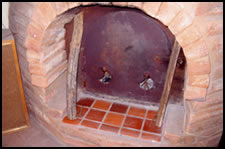A Good Manual for Cold Weather builders ~
A Masonry Stove Classic is once again available |
How about efficiencies of 85-90% from a wood-burning masonry stove?
Enter the manual "Russian Fireplace Demonstrations
and Workshops" by
Jay S. Jarpe, research engineer, May 1981. Long out of print,
this approximately 90 pp. manual ( 8 1/2" x 11") covers the
design, construction, and thermal performance of a type of European
masonry stove known in
Russia as a Grubka. In 1980, an innovative
New Mexico adobe mason, Robert Proctor, received a State grant to construct
eight of these stoves in
Community and Senior Citizens' Centers at Taos, Nageezi, Santa Fe, Las
Vegas, Albuquerque, Willard, Roswell and Silver City, New Mexico. Elevations
ranged from 7000' to 3500'. Efficiencies ranged
from a low of 86% at Silver City to a high of 89% at Willard. These
are much higher efficiencies than can be attained by most metal stoves
available on the market
today.
 |
| An overall view of an installed Grubka. |
Readers are familiar with these stoves as advertised in magazines such
as Fine Homebuilding or This Old House. They are usually
imported "prefab" models,
are too small to heat larger spaces and they aren't cheap. The shortfall is
that it's not easy to find anyone that knows how to build one, or to find a
set of plans to build one. With this manual, you'll find all of the thermal
documentation as well as the plans. Moreover, there are figures plotting temperature
changes over time in all eight varieties of the stove. The text gives the builder
plenty of direction about placement of rebar, type and strength of masonry
mixes and pitfalls to watch out for.
The project was sponsored by The University of New Mexico, and funded
through the New Mexico Energy Institute. Built of block, adobe, brick
and other masonry,
the eight stoves were fitted with thermocouples to measure their thermal
performance and to determine how heat traveled through them. To better
define the stove,
we quote from the manual:
"The Russian fireplace is a high-mass masonry
wood stove with a circuitous flue that allows the heat in the flue stream
to be transferred to the masonry for later release to the area to be
heated. Variations of this type of wood heater are common in colder European
climates. It could be a Finnish, Swedish, Polish, Austrian, German or
Italian stove. The Mennonites of Nebraska built a labyrinth flue heater
that burned grass or straw. All varieties have high masonry mass, long
flow path, and resulting high efficiencies in common. The user may gather
less wood and tend the fire for only short periods each day to achieve
comfortable surroundings. The wood can be scrap limbs or other inferior
shapes up to four feet long. Wood with diameters of 2" or less will
give the best efficiency."
The above means that owners of these stoves no longer have to purchase "thick" wood
by the cord. Salt cedar, or forest slash (often free to gatherers to
reduce fire danger), or trimmings from orchards are ideal, as are wood
construction scraps.
One of the remarkable features of these stoves is that they are very
clean, that is, they burn up all pollutants. When a firing is underway,
one can go
outside and look at the top of the chimney flue. You will see no smoke, only
the shimmering effect of the heat as seen when looking at a mirage. This
indicates a flue temperature at around 1100°F. As Jarpe points out,
"Smoke is generally composed of water vapor
and tar droplets that condense when they contact the cold air. When the
tar is ignited and all water is driven off, and the flue temperature
is high enough to be well above the condensation temperature, the smoke
visibly disappears. At this point, combustion is nearly complete."
 |
| A view of the Grubka's firebox steel door with typical wood fuel
of small diameter. |
Sections and elevations are provided in the
manual at ½" =
1' 0" and cover 25 pages. These include details of foundations,
the masonry itself, steel placement, damper assemblies and the design
of the steel front door (3/16" hot rolled steel) and its important
air inlet ports. 12 pages are dedicated to graphs plotting heat flow
through the stoves over time. The remaining text is straightforward
and informative.
A difference in building a Grubka as compared to a standard or Count
Rumford fireplace is that the Grubka will cost more in materials
and time. They are larger, and the entire oven, masonry arches and flue path must be constructed
of firebrick, using fireclay mortar. Concrete block or adobe or red brick
may be used in the "shell" surrounding the inner firebrick core.
 SWSA
sends you this manual in a 3-ring notebook for $27. SWSA
sends you this manual in a 3-ring notebook for $27.
(Price includes priority
mail to you and all applicable taxes.)
|
